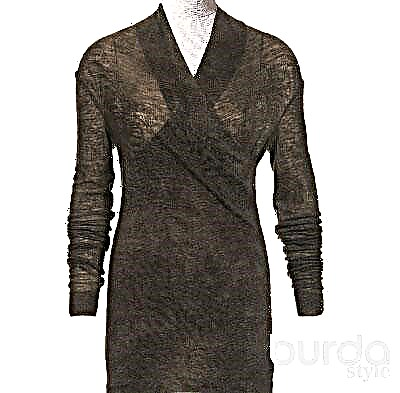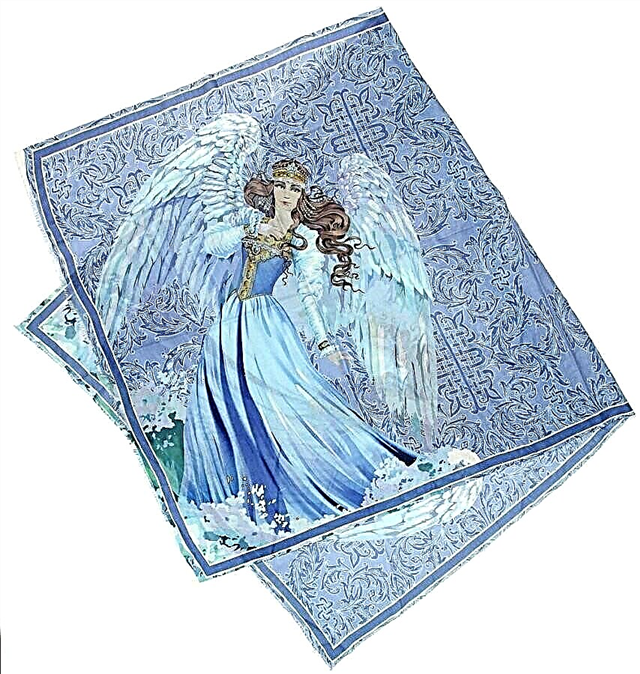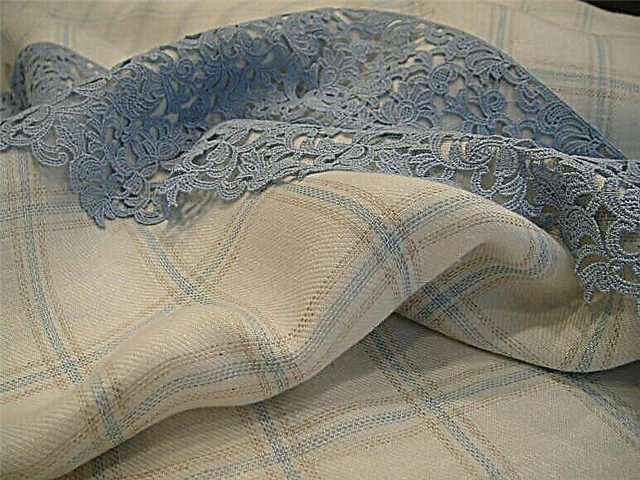Share
Pin
Tweet
Send
Share
Send
Our pullover has a little trick, but even beginners can make such a model. We will show how to do this step by step.

Pullover 114 A from Burda magazine 11 2011
YOU WILL NEED:
• thin knitted fabric shir. 120 cm: size 34 - 1.85 m, size 36 - 2.35 m, size. 38, 40 - 2.50 m, size. 42 - 2.55 m; • threads for sewing;
• needle of a sewing machine for knitwear No. 70−80;
• double needle of the sewing machine; • 2 large buttons for sewing;
• silk paper for transferring patterns from a sheet of patterns;
• pencil, paper scissors; • tape measure;
• carbon paper burda, a gear wheel for translating patterns;
• tailor's chalk; • tailor pins;
• cutting scissors and small needlework scissors

Pattern
... pink, so it is easy to find on the sheets of patterns. Put silk paper on a sheet of patterns and pin it. Translate the details of the pattern of your size along the corresponding contour lines and do not forget about the markings, inscriptions, as well as cross marks! Cut out the details of the pattern.
Tip: you can simplify your cutting by reshaping the front pattern, and for sizes 38–42, the sleeve pattern twice.

Layout Plans
... show how to arrange the details of the paper pattern on a knitted fabric - fold the knitted fabric in half with the face inward, fold the knitted fabric face up in one layer. Place a paper pattern of the back on a knitted fabric, combining the line of the middle of the back with a fold.
1 = Front, one-piece with a yoke back, 2x
2 = Back, 1x fold
3 = Sleeve, 2x

Extra Tips
The size of the pullover is determined by the circumference of the chest (size 34 = 80 cm, size 36 = 84 cm, size 38 = 88 cm, size 40 = 92 cm, size 42 = 96 cm).
For this model, use only thin knitted or knitted fabrics. When sewing cutting parts, use a special needle of a sewing machine for knitwear with a rounded end, which does not pierce the fabric, but gently spreads its loops.

Cut
Fold the knitted fabric along in half with the front side inwards. For size 34: lay part 2 on a knitted fabric, aligning the line of the middle of the back with a fold, pin it. Put part 3 on a knitted fabric and pin it. Mark the allowances around the pattern details: for hemming the bottom of the pullover - 4 cm, for hemming the bottom of the sleeves - 6 cm, for all other sections - 1.5 cm. Cut out the details.

Fold the remaining flap of the knitted fabric in one layer face up. Place part 1 on the knitted fabric twice: once with the inscription side up and once with the inscription side down. Please note that the lines of the shared thread of the paper pattern parts must be parallel to the edge! For sizes 36–42, cut the parts according to the layout plans.

Seam lines and marking
For cross marks on allowances, perform notches. On each sewing detail (a paper pattern rests on a piece of cut from a knitted fabric), lay large stitches of the “forward needle” seam along the middle line of the front, the fold line (neckline) and the double-thread alignment line, leaving a loop of approx. 2 cm. In the middle between the detail of the cut and the paper pattern of the loop, cut. Then carefully remove the paper pattern.Neck and middle sh
 o yoke back
o yoke backTrim the longitudinal sections of the whole cut with parts of the front of the neckline. On the right side of the front grinder, unscrew along the fold line to the wrong side and pin it at a distance of approx. 3 cm from the fold. Do not iron.

Place the right part of the front on the left part of the front with the front side to the front side, on the whole-cut with the parts of the front yoke back, chop the middle sections.

The neck and middle seam of the back yoke
Turn the whole-necked piece from the left side of the front to the right side of the front, rounding the neck, pin along the middle sections of the back of the yoke.Make the middle seam of the back yoke (with 1.5 cm seam allowances).
Cut the seam allowances to a width of 7 mm and overcast together.

Fold out the left and right parts of the front. On the left side of the front, turn the neckline to the wrong side and notice. Do not iron the edge.

Place the right part of the front on the left side of the front, aligning the lines of the middle of the front and the edges of the necks, respectively, with the alignment lines, sweep side sections from both sides.

Stitch back
Place the backrest on the one-piece front yoke, with the front side facing the front side, and chop the cross sections. Stitch (with 1.5 cm seam allowances), cut the seam allowances to a width of 7 mm, overcast and iron down.

Side seams
Before laying on the back, face to face. Chip side sections on each side. Stitch (with 1.5 cm seam allowances). Cut the allowances of each seam to a width of 7 mm, overcast and iron on the back.

Bending the bottom of the pullover and sleeves
The allowances for bottom hem - on the pullover 4 cm wide, on the sleeves 6 cm wide - iron on the wrong side. On the front side, seam allowances with a double needle: for bending the bottom of the pullover at a distance of 3 cm, for bending the bottom of the sleeves at a distance of 5 cm.

Sleeve seams
Fold each sleeve along in half with the front side inwards, chop off the slices. Stitch (with 1.5 cm seam allowances). Cut the seam allowances to a width of 7 mm and overcast together. Turn out a sleeve.

Stitch sleeves
Pull each sleeve first only into the lower part of the armhole (face to face), aligning the sleeve seam with the side seam, as well as the notches on the sleeve and the front (reference marks 4).

Then combine the shoulder marks (the upper notch of the armhole and the notch on the sleeve ridge) and chip. Insert a sleeve into the armhole at an angle. Sweep the sleeve, then stitch it. Sew in the seam allowances close to the stitch and sew together.
Photo: U2 / Uli Glazeman. Illustrations: Elke Trier-Schäfer. Text: Hydem Arithen Gler-Staldelm Ayer.
Share
Pin
Tweet
Send
Share
Send



